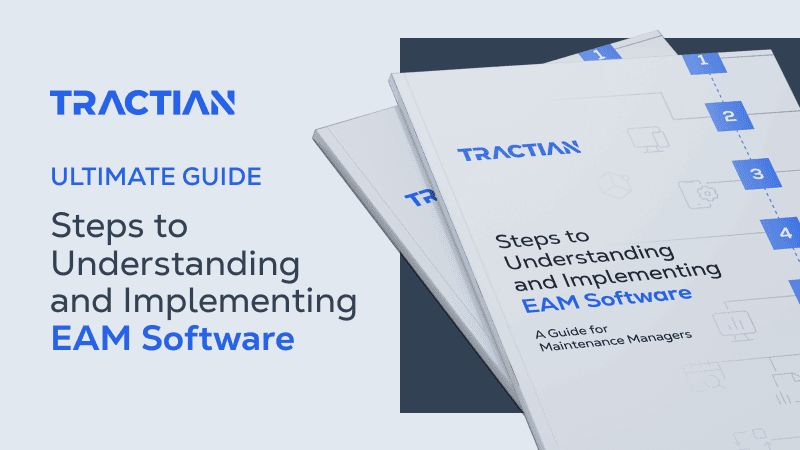The most successful industrial operations have one thing in common: they don’t wait for failures to happen-they prevent them. A structured maintenance plan is the key to reliability, efficiency, and cost control.
A clear, action-oriented preventive maintenance schedule keeps your assets running at peak performance when it matters most.
Many maintenance teams start with an Excel template to organize their schedules. It’s a simple, familiar tool for tracking tasks, monitoring asset health, and assigning responsibilities.
But on its own, it’s not enough.
Let’s explore how to strengthen your maintenance strategy.
What Is a Maintenance Schedule?
A maintenance schedule is the backbone of an effective maintenance strategy, defining the "what," "when," and "who" for every task needed to keep equipment running smoothly.
Whether you're managing a small facility or a large industrial operation, a structured schedule ensures planned work happens on time-reducing downtime and preventing costly surprises.
Fundamentally, a maintenance schedule is a detailed timeline that organizes and tracks all activities required to maintain your assets.
It provides clear direction for the maintenance team, ensuring tasks are prioritized and completed in alignment with manufacturer-recommended maintenance schedules.
This structure streamlines regular maintenance, extends asset lifespans, and enhances operational efficiency.
What Is the Purpose of a Maintenance Schedule?
A strategic maintenance schedule goes beyond preventing failures to proactively align maintenance tasks with production goals. Succeeding with this proactive approach requires balancing two key objectives:
- Maximum Equipment Uptime - A well-planned schedule reduces unexpected breakdowns, ensuring machines are available when you need them.
- Optimized Resources - Efficient task organization helps you make the most of your team, tools, and spare parts inventory.
A maintenance schedule becomes much more than just a checklist when used consistently and effectively. It transforms into a strategic tool that improves every operational metric: greater efficiency, reduced risks, compliance with safety and regulatory standards, and more.
Types of Maintenance Schedules
Choosing the right maintenance schedule depends on the complexity of your operation.
Here are the most common types:
- Preventive Maintenance Schedule - Based on manufacturer recommendations, historical data, or usage patterns, this approach addresses potential issues before they occur, extending asset lifespan and ensuring consistent performance.
- Time-Based Maintenance Schedule - Tasks are scheduled at set intervals (e.g., weekly, monthly, annually), making it ideal for equipment with predictable wear and tear.
- Condition-Based Maintenance Schedule - Maintenance is triggered by real-time data insights, such as vibration analysis or temperature fluctuations, helping to catch issues before they escalate.
- Predictive Maintenance Schedule - Using advanced analytics, this proactive approach forecasts failures before they happen, making it a highly cost-effective strategy.
- Corrective Maintenance Schedule - A reactive approach that focuses on repairing equipment after failure, best suited for non-critical assets.
Understanding these categories allows you to tailor your maintenance plan to fit your equipment and industry needs.
Ready to take control of your maintenance plan? Download our free maintenance schedule calendar template in Excel-your go-to tool for structuring tasks, tracking asset performance, and assigning responsibilities efficiently.
Building the Backbone of Your Maintenance Plan

A preventive maintenance schedule isn't just a list of tasks. To keep your organization on track, you have to strategically maximize uptime, extend asset life, and keep operations running smoothly. A checklist of tasks will not get the job done.
Here are the key elements every maintenance schedule should include:
1. Map Out Equipment and Services
Start by cataloging all machines, equipment, and their maintenance requirements.
For each asset, ask:
- What type of maintenance is needed-a time-based maintenance schedule, condition-based maintenance schedule, or another approach?
- How often should maintenance tasks be performed?
This initial mapping ensures no equipment is overlooked and lays the foundation for a well-structured maintenance strategy.
2. Define Maintenance Frequency
Each piece of equipment has unique maintenance needs. Some machines require weekly manufacturer-recommended maintenance schedules, while others only need annual inspections. The key is to tailor the frequency to each asset’s specific requirements based on usage patterns and wear.
3. Provide Detailed Task Descriptions
Ambiguity leads to misunderstanding and preventable mistakes. Each maintenance activity should include detailed, step-by-step instructions to ensure tasks are executed correctly. This helps reduce downtime and maintain consistent equipment performance.
4. Assign Responsibility and Ensure Traceability
Every maintenance task should be assigned to a specific technician or manager. Clear accountability-along with approvals or signatures-ensures compliance, maintains accurate records, and keeps maintenance work on track.
What Are The Benefits of Scheduled Maintenance?
An industrial facility or company cannot impact its bottom line through maintenance management without a well-defined and implemented maintenance schedule.
By organizing tasks, allocating resources, and ensuring timely execution, scheduled maintenance enhances reliability, optimizes performance, and prevents costly disruptions.
Below are the key benefits of adopting a structured maintenance schedule strategy.
Streamlined Organization and Enhanced Control
A preventive maintenance schedule turns planning into action. Instead of reacting to unexpected failures, your team operates with clarity and purpose.
With a clear roadmap of tasks, responsibilities, and timelines, there’s no confusion about who is handling what or when critical maintenance work is due.
This proactive structure ensures every piece of equipment receives the attention it needs, boosting reliability across the board. As a result, your shop floor becomes more predictable, allowing your team to focus on performance rather than firefighting emergencies.
Time and Cost Savings That Matter
Unplanned downtime is one of the most expensive challenges in industrial operations. A structured preventive maintenance schedule directly addresses this issue by predicting and preventing failures (and, therefore, downtime) before they occur.
The result? Significant time and cost savings, including:
- Less reliance on emergency repairs.
- More efficient use of labor and resources.
- Extended equipment lifespan, reducing replacement costs.
Building Customer Loyalty Through Reliability
The impact of reliability in your industry extends beyond internal operations. Reliability builds a reputation for your business that your customers enjoy - and rely on.
A business that runs smoothly, without unexpected delays or quality issues, earns customer confidence.
By ensuring machines operate at peak performance, you can consistently meet deadlines, maintain product quality, and avoid disruptions that undermine customer trust.
This level of reliability fosters loyalty and sets your business apart from competitors. Customers value dependable partners, and your ability to deliver-powered by proactive maintenance strategies-positions you as an industry leader.
Enhancing Safety and Operational Compliance
A well-executed preventive maintenance schedule plays a critical role in workplace safety. When machines are properly maintained, the risk of mechanical failures that could endanger employees is drastically reduced.
Beyond safety, staying on schedule ensures compliance with industry regulations, helping you avoid costly fines or operational shutdowns due to non-compliance.
Employees feel more secure working with well-maintained equipment, and stakeholders gain peace of mind knowing your operation meets or exceeds regulatory standards.
Maximizing Asset Performance
The longer your equipment lasts, the greater your return on investment. A preventive maintenance schedule helps you get the most from every asset by:
- Following manufacturer-recommended maintenance schedules to prevent premature wear.
- Addressing minor issues before they escalate into costly failures.
- Ensuring optimized performance, which leads to fewer bottlenecks and higher productivity.
Scheduled maintenance also supports sustainability efforts by extending equipment life, reducing waste, and lowering the environmental impact of frequent replacements.
Data-Driven Insights for the Future
A detailed maintenance schedule optimizes your operations now and in the future.
Tracking maintenance work and asset performance allows you to identify trends, refine processes, and improve efficiency over time.
By integrating maintenance management software, you can take this a step further with real-time data collection and predictive analytics-enabling a shift from reactive fixes to proactive optimization.
Transforming Challenges into Competitive Advantages
The real power of a preventive maintenance schedule lies in its ability to transform challenges into strategic advantages. You create a resilient, high-performing operation by reducing downtime, improving efficiency, and ensuring consistent quality.
Whether you start with a maintenance schedule template in Excel or transition to a more advanced system, the benefits are clear: greater control, lower costs, and a proactive maintenance strategy that drives long-term success.
How to Make a Maintenance Schedule
A well-structured maintenance schedule ensures equipment receives the right care at the right time.
But how do you create a schedule that truly works?
Let’s break it down step by step.
1. Mapping All Equipment
Before creating a maintenance schedule, you need a complete inventory of all your facility's machines, equipment, and tools.
This step, often overlooked, provides the visibility needed to manage assets effectively.
- Why it matters: Peter Drucker famously said, “You can't manage what you can't measure.” Mapping your equipment gives insight into what’s being used, how often, and where maintenance efforts should focus.
- Pro tip: Expand your inventory to include sub-assets, spare parts, and tools. A comprehensive map supports more precise planning.
2. Setting Maintenance Priorities
Not all equipment carries the same level of importance. Some assets, if they fail, can halt production, while others may have a lesser impact.
Start by identifying critical assets-the machines and components whose performance is vital to your operation.
- How to prioritize: Assess each asset based on cost, risk, and operational impact. Beyond the equipment’s price tag, consider how downtime affects production.
- The goal: Allocate maintenance resources efficiently, prioritizing high-impact assets while ensuring lower-priority equipment still receives proper care.
3. Establishing Maintenance Frequency
Every piece of equipment has unique maintenance needs. The frequency of maintenance depends on usage intensity, operational conditions, and historical performance data.
- Start with the basics: Use manufacturer-recommended maintenance schedules as a baseline.
- Adjust for reality: Factor in workload, past maintenance history, and seasonal production demands. Machines with heavy daily use may need more frequent checks, while less-used equipment might only require periodic inspections.
Balancing maintenance frequency with production demands ensures equipment availability without overloading the maintenance team.
4. Scheduling Maintenance at the Right Times
A maintenance schedule is only as effective as its timing. Plan tasks to minimize disruptions by scheduling work during off-hours or low-demand periods.
- What to include: Define specific dates and times for inspections, servicing, and part replacements. Indicate downtime windows if necessary.
- Why it matters: Performing maintenance during peak production hours can be costly. Scheduling strategically ensures equipment is serviced without affecting output.
For example, a manufacturer could schedule conveyor belt inspections overnight or during shift changes to avoid production delays.
5. Assigning Responsibilities
Clear accountability is key to an effective maintenance strategy. Assign specific technicians or teams to each task, ensuring responsibilities are well-defined.
- Why it’s essential: Designating responsibility eliminates confusion and ensures the right expertise is applied to each job.
- How to do it: Include technician names or roles in the maintenance schedule. If an issue arises, tracking accountability becomes seamless.
6. Including Key Data in the Schedule
A well-documented maintenance schedule does more than outline tasks-it serves as a historical record for troubleshooting and continuous improvement.
- What to document: Record dates, times, tasks performed, parts used, costs incurred, and any issues identified during maintenance work.
- The benefits: Detailed records help detect patterns, such as recurring failures or abnormal wear. They also provide insights into training needs and process improvements.
For example, noticing consistent wear on a specific cutting tool might signal a need for improved employee training or operational adjustments.
Maintenance Schedule Template Excel
A maintenance schedule template in Excel is a practical, user-friendly tool that helps centralize and organize maintenance efforts.
Whether you’re overseeing a small operation or managing an entire facility, it provides a simple, structured way to schedule tasks, track progress, and assign responsibilities.
As a ready-to-use solution, it is an essential starting point for organizing maintenance work, assigning responsibilities, and maintaining control over operations.
Why Use an Excel Template for Your Maintenance Schedule?
A maintenance schedule template in Excel offers an accessible, customizable way to structure your maintenance plan. It provides a clear framework to:
- Centralize information: Track tasks, timelines, and resources in one easy-to-navigate sheet.
- Streamline communication: Clearly outline responsibilities and deadlines for every maintenance task.
- Ensure consistency: Standardize regular maintenance procedures, reducing the risk of missed or duplicated tasks.
With features like color-coded fields and pre-built columns for task names, deadlines, and asset information, an Excel template simplifies what could otherwise be a tedious process.
The Key Elements of a Maintenance Schedule Template
A well-structured Excel maintenance schedule template typically includes the following:
- Task List: A comprehensive, detailed breakdown of maintenance activities, from inspections to part replacements.
- Frequency: Specifies how often each task should be performed-daily, weekly, monthly, or annually.
- Assigned Personnel: Clear documentation of who is responsible for executing each task.
- Asset Details: Information on the equipment or machinery being serviced, ensuring no asset is overlooked.
- Status Tracking: A space to mark tasks as pending, in progress, or completed, providing a real-time overview of progress.
Getting the Most Out of Your Excel-Based Schedule
To get the most value from your maintenance schedule template in Excel, treat it as a dynamic resource.
Regularly update it to reflect changes in equipment conditions or team responsibilities. Reviewing historical data can also help fine-tune maintenance frequencies based on patterns of wear or use.
With consistent updates, an Excel template becomes an integral asset in your preventative maintenance strategy.
Automating Maintenance Schedule Control
Automation enables real-time monitoring, dynamic scheduling, and data synchronization. Automated maintenance systems ensure optimal team performance. They plan and schedule tasks in advance while adapting to real-time conditions.
On the other hand, managing a maintenance schedule manually is tedious, time-consuming, and carries a high risk of human errors and mistakes. From tracking tasks and timelines to coordinating teams, the process can quickly become overwhelming-especially in larger, more complex operations.
The good news? Modern technology streamlines and optimizes the entire process, allowing you to focus on strategy instead of tedious operational details.
External Team Management Systems
External team management systems mark a significant leap forward in maintenance management, providing advanced tools to monitor, organize, and execute tasks with unmatched efficiency.
These systems go beyond basic scheduling by offering real-time visibility into team activities. With features like task tracking, location monitoring, and automated reporting, they allow for precise and flexible oversight of maintenance operations.
How It Works in Practice
Here’s how external team management systems enhance and simplify maintenance scheduling:
- Real-Time Monitoring: Track team locations and task progress in real time, ensuring work stays on schedule.
- Task Management: Assign and organize tasks efficiently, complete with deadlines, priorities, and required resources.
- Dynamic Adjustments: Instantly update schedules and reallocate resources in response to unexpected events like equipment failures or staffing changes.
- Data Integration: Syncs with condition-based monitoring systems or maintenance management software, creating a unified platform for all maintenance needs.
Automation in Maintenance
While maintenance automation is definitely more convenient, its actual value as a strategic investment is realized over time as efficiency, precision, and scalability increase.
By reducing manual effort, automation minimizes human error and ensures every maintenance task is executed as planned.
With automation, managers can:
- Focus on high-level decision-making instead of day-to-day task coordination.
- Improve maintenance team productivity with more precise directions and priorities.
- Increase accuracy by relying on data-driven insights.
Automation in maintenance, like in other areas of business, will lighten the workload. However, when deployed in industrial operations, it also raises the bar for efficiency.
By leveraging external team management systems, you can align your maintenance strategy with modern technology standards, achieving a level of performance that was once out of reach.
Conclusion
In this article, we've shown how a well-defined maintenance schedule becomes a strategic roadmap that enhances operational efficiency, reduces costs, and improves reliability.
Using a structured schedule, your machines and equipment stay in optimal condition, minimizing downtime and maximizing productivity across your operations.
But you can take this even further.
Modern technology enables maintenance routines to be automated and optimized, going beyond traditional, manual methods.
With real-time data and actionable insights, maintenance teams can transition from reactive or manual processes to connected, proactive strategies that drive efficiency.
To help you get started, Tractian offers a free maintenance plan calendar template in Excel, designed to simplify your planning process. It’s a practical, user-friendly tool that lays the foundation for a well-structured maintenance schedule.
Download it here for free and take the first step toward improving your maintenance strategy today.


